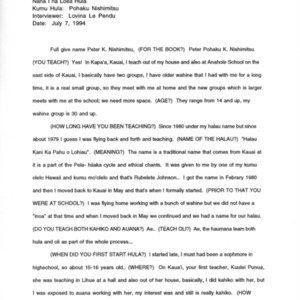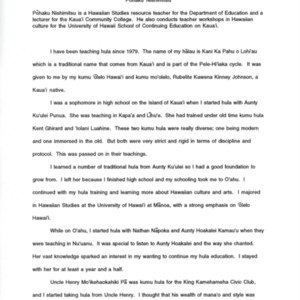Pōhaku Nishimitsu
Title
Pōhaku Nishimitsu
Subject
Nā Kumu Hula Pohaku Nishimitsu - Nānā I Nā Loea Hula Volume 2 Page 90
Description
Pōhaku Nishimitsu is a Hawaiian Studies resource teacher for the Department of Education and a lecturer for the Kaua‘i Community College. He also conducts teacher workshops in Hawaiian culture for the University of Hawaiʻi School of Continuing Education on Kaua‘i.
I have been teaching hula since 1979. The name of my halau is Kani Ka Palm o LohiʻPau which is a traditional name that comes from Kauai and is part of the Pele-Hi'iaka cycle. It was given to me by my kumu ‘olelo Hawaii and kumu mo‘olelo Rubellite Kawena Kinney Johnson, a Kauai native.
When I think of traditional hula, I look for a mele that has a real connection to nā kupuna kahiko. Hence it has a solid foundation; it has a concrete link with the past. Traditions are like an unbroken piece of thread. It connects every era and that thread is going to continue stringing us into the next century. It will be linked back to us and back to our kupuna who came before us. Tradition has a grounding, a basis in the past, and is carried on for the future generations.
I was a sophomore in high school on the Island of Kaua‘i when I started hula with Aunty Ku‘ulei Pūnua. She was teaching in Kapa‘a and Llhu‘e. She had trained under old time kumu hula Kent Ghirard and lolani Luahine. These two kumu hula were really diverse; one being modern and one immersed in the old. But both were very strict and rigid in terms of discipline and protocol. This was passed on in their teachings.
I learned a number of traditional hula from Aunty Ku'ulei so I had a good foundation to grow from. I left her because I finished high school and my schooling took me to O‘ahu. I continued with my hula training and learning more about Hawaiian culture and arts. I majored in Hawaiian Studies at the University of Hawaiʻi at Manoa with a strong emphasis on ‘ōlelo Hawaii.
While on O‘ahu I started hula with Nathan Napoka and Aunty Hoakalei Kamau‘u when they were teaching in Nuʻuanu. It was special to listen to Aunty Hoakalei and the way she chanted. Her vast knowledge sparked an interest in my wanting to continue my hula education. I stayed with her for at least a year and a half.
Uncle Henry Moʻike-haokahiki Pa was kumu hula for the King Kamehameha Civic Club and I started taking hula from Uncle Henry. I thought that his wealth of mana‘o and style was really neat because he was one of the oldest kumu hula still teaching. It was fabulous being able to learn things from someone who had been doing it all his life.
After Uncle Henry I moved to Darrell Lupenui and Waimāpuna. It was very different because I was usually in a combined men and women class and now I was in a group made lip of all men. They were robust and able to do totally different styles of hula from what I was doing before. Darrell was founded in traditional mana‘o and styling but he was also very innovative and he tried to meld the two to make a pleasing kind of picture so that the kupuna would not find his hula offensive.
After a year Darrell, Thaddius Wilson, and O'Brian Eselu found it necessary to go their separate ways. A bunch of us went with O'Brian and Thaddius and formed Na Wai ʻEhā O Puna in the summer of 1978. I stayed with them for three years.
I have a great deal of respect for Uncle Henry Pa and Aunty Edith Kanaka‘ole because they taught with great aloha and humility and they conveyed what they believed through what they did. Their actions proved they were living what they talked about. Also both of them were fluent Hawaiian speakers so they knew of the nuances and things hidden away to those not maʻa i ka ‘ōlelo makuahine (not familiar with the mother tongue). They were gifted. Through them I learned that the ‘ōlelo is of vital importance to hula. Without proper ‘ōlelo, how can you have proper hula?
“Pono nō e a‘o mai i ka ‘ōlelo Hawaiʻi; ‘oi‘a ka mea nui. A e a‘o mai i ka hula o kou ‘aina ponoʻī.” Language is the key that opens doors. These passages shed light on things of the past; some of which are no more. We may never know everything but that’s the beauty of the hula and the mele—its subtlety. Now more so than ever I am very happy to be able to watch other people do their hula and enjoy what they are trying to do and share because of this resurgence i ka ‘olelo Hawaiʻi.
90 Pohaku Nishimitsu
I have been teaching hula since 1979. The name of my halau is Kani Ka Palm o LohiʻPau which is a traditional name that comes from Kauai and is part of the Pele-Hi'iaka cycle. It was given to me by my kumu ‘olelo Hawaii and kumu mo‘olelo Rubellite Kawena Kinney Johnson, a Kauai native.
When I think of traditional hula, I look for a mele that has a real connection to nā kupuna kahiko. Hence it has a solid foundation; it has a concrete link with the past. Traditions are like an unbroken piece of thread. It connects every era and that thread is going to continue stringing us into the next century. It will be linked back to us and back to our kupuna who came before us. Tradition has a grounding, a basis in the past, and is carried on for the future generations.
I was a sophomore in high school on the Island of Kaua‘i when I started hula with Aunty Ku‘ulei Pūnua. She was teaching in Kapa‘a and Llhu‘e. She had trained under old time kumu hula Kent Ghirard and lolani Luahine. These two kumu hula were really diverse; one being modern and one immersed in the old. But both were very strict and rigid in terms of discipline and protocol. This was passed on in their teachings.
I learned a number of traditional hula from Aunty Ku'ulei so I had a good foundation to grow from. I left her because I finished high school and my schooling took me to O‘ahu. I continued with my hula training and learning more about Hawaiian culture and arts. I majored in Hawaiian Studies at the University of Hawaiʻi at Manoa with a strong emphasis on ‘ōlelo Hawaii.
While on O‘ahu I started hula with Nathan Napoka and Aunty Hoakalei Kamau‘u when they were teaching in Nuʻuanu. It was special to listen to Aunty Hoakalei and the way she chanted. Her vast knowledge sparked an interest in my wanting to continue my hula education. I stayed with her for at least a year and a half.
Uncle Henry Moʻike-haokahiki Pa was kumu hula for the King Kamehameha Civic Club and I started taking hula from Uncle Henry. I thought that his wealth of mana‘o and style was really neat because he was one of the oldest kumu hula still teaching. It was fabulous being able to learn things from someone who had been doing it all his life.
After Uncle Henry I moved to Darrell Lupenui and Waimāpuna. It was very different because I was usually in a combined men and women class and now I was in a group made lip of all men. They were robust and able to do totally different styles of hula from what I was doing before. Darrell was founded in traditional mana‘o and styling but he was also very innovative and he tried to meld the two to make a pleasing kind of picture so that the kupuna would not find his hula offensive.
After a year Darrell, Thaddius Wilson, and O'Brian Eselu found it necessary to go their separate ways. A bunch of us went with O'Brian and Thaddius and formed Na Wai ʻEhā O Puna in the summer of 1978. I stayed with them for three years.
I have a great deal of respect for Uncle Henry Pa and Aunty Edith Kanaka‘ole because they taught with great aloha and humility and they conveyed what they believed through what they did. Their actions proved they were living what they talked about. Also both of them were fluent Hawaiian speakers so they knew of the nuances and things hidden away to those not maʻa i ka ‘ōlelo makuahine (not familiar with the mother tongue). They were gifted. Through them I learned that the ‘ōlelo is of vital importance to hula. Without proper ‘ōlelo, how can you have proper hula?
“Pono nō e a‘o mai i ka ‘ōlelo Hawaiʻi; ‘oi‘a ka mea nui. A e a‘o mai i ka hula o kou ‘aina ponoʻī.” Language is the key that opens doors. These passages shed light on things of the past; some of which are no more. We may never know everything but that’s the beauty of the hula and the mele—its subtlety. Now more so than ever I am very happy to be able to watch other people do their hula and enjoy what they are trying to do and share because of this resurgence i ka ‘olelo Hawaiʻi.
90 Pohaku Nishimitsu
Citation
“Pōhaku Nishimitsu,” Nā Kumu Hula Archive, accessed August 25, 2025, https://nakumuhula.org/archive/items/show/143.






